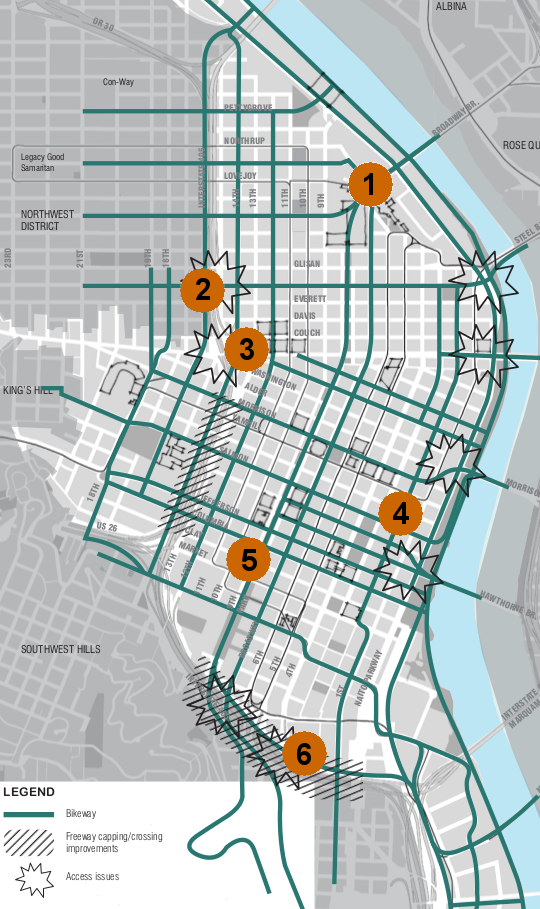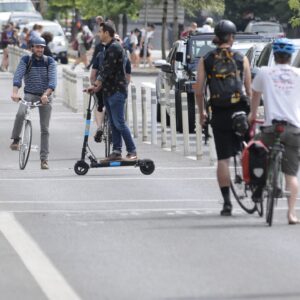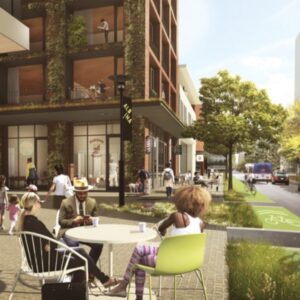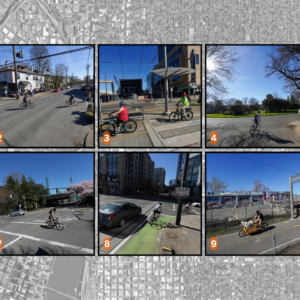
For months, the Portland Bureau of Transportation has been mum about its ideas for how to spend the $6.6 million for better downtown transportation that has been working its way through the bureaucratic pipeline.
Yesterday, Metro Council approved the plan. So it’s high time we got the serious speculation started — and the map above is a fine place to begin.
This is map 5d from the city’s West Quadrant Plan, which is planning the future of the area most Portlanders just call “downtown.” It’s focused on which routes and connections the city would prioritize for bike traffic over the next few decades or so. Even though it’s actually a long-term planning document, this map was put together with lots of help from transportation planner Mauricio LeClerc of PBOT, who’s plugged in to the short-term discussions happening behind the scenes at PBOT.
Early this week, I spoke with LeClerc about some of the many interesting details of this map — which, keep in mind, includes many long-term goals as well as possible short-term ones.
Downtown, LeClerc said, “should be a nice place to bike around,” especially with “bikeshare and all the new users that will come with that.” Yet “the bicycle network is the least developed in the west quadrant, in the central city in general” compared to the rest of Portland, he said.
Here are a few details from their long-term plan to fix that.
1) The Broadway Bridge connection.
We noticed two things about this part of the map right away. First, it’s the only downtown crossing that’s not marked as having “access issues.” Though Northwest Broadway’s wide new bike lanes are a big improvement, the connection is far from perfect. Should we be calling the west-side bridge landings the Great Wall of Portland Biking?
Second, the marked bike routes here go straight through a large building … the downtown Post Office. “The Post Office is the Post Office, and they may not want to move,” LeClerc said. On the other hand, they “may want to relocate to the airport,” at least their trucking operation. That’d create some big new possibilities for the Northwest. LeClerc said he’d heard “employment industrial more than residential” discussed for the area. But in the absence of long-term information, the planning office simply drew a line through the property, which has some interesting effects (see No. 5 below).
2) The Flanders crossing of I-405.
Step into your time machine: LeClerc said to make this crossing work, we’ll need a bridge.
“This is a long-term vision,” LeClerc said. “That’s all very expensive, but that’s how we build what we’ve [planned].”
A bridge here — between downtown and the dense neighborhoods of Northwest Portland — was very close to a reality; but after political pressure became too intense, mayoral candidate Sam Adams scrapped the idea in 2008. A new bridge over I-405 is still in the 2030 bike plan, which designates Flanders as the only continuous bike corridor in the area.
3) The Couch crossing of I-405.
Though neither Burnside or Couch is marked as a bike corridor, LeClerc said this tough crossing might finally get some help “very soon” in making it less auto-dominated.
“We got some TIP money to make improvements in that area,” he said. “We will take some of the roads out and install a couple more signals. [At Couch] we’re going to make it more obvious that you’re actually crossing a street.”
4) SW Second Avenue: downtown’s missing north-south bikeway?
If you don’t want to cross Naito and don’t feel like mixing with the absurd traffic behaviors on the transit mall, downtown is not an intuitive place for biking north and south.
LeClerc said a dedicated bikeway on Second Avenue could solve that.
“Fourth has a lot of auto demand and a lot of parking structures, and a lot of demand for right turns onto the bridges, so we thought a bike lane would create a lot of conflicts,” LeClerc said. Second, by contrast, “can get you up from Southwest Portland, but also it can get you access to the bridges and Old Town.”
On the other hand, Fourth Avenue is a popular place to drive for the same reasons it could be a popular place to bike: it’s closer than Second Avenue to many popular destinations and it provides a good connection to the Broadway Bridge. Still, Second Avenue could work.
5) A Park Blocks bikeway?
Remember when Adams was planning a parking-protected bike lane on the North Park Blocks as part of his first 100 days as mayor? Me, neither. But some have thought for years that the Park Blocks could make a great connector — even a car-free space like they are near Portland State University.
This idea is vague — planners simply drew a line down the middle of both the north and south Park Blocks — but it’s too interesting to ignore, especially if it could be a straight shot from the Broadway Bridge to the Powell’s Books area and on south to PSU.
6) Freeway caps.
At a conference last spring, I heard a Florida traffic engineer say Portland will never live up to its mythical reputation until it removes the “noose” of freeways that “choke” its central city. The city has no plans to do that — in fact, it’s looking for ways to invest in the freeway connections in an effort to remove speeding traffic from the streets near PSU — but it is making long-term plans to build “caps” over I-405 at these shaded areas, perhaps as part of the same project.
“It is abstract, but it’s a desire,” LeClerc said. “It’s just filling in a tunnel. You can actually cap something and maintain the mobility underneath. … Reconnecting the PSU area south of downtown to the area just south of it — reconnecting that barrier that the freeway creates — that’s something we would like to do.”







Thanks for reading.
BikePortland has served this community with independent community journalism since 2005. We rely on subscriptions from readers like you to survive. Your financial support is vital in keeping this valuable resource alive and well.
Please subscribe today to strengthen and expand our work.
Unless a lot has changed very recently, the post office is already planning on relocating to the airport. I was on the Pearl district planning committee until 2009. At that time it appeared to be just a matter of time. That would make 9 new city blocks including 3 new north park blocks!
The current post office site is a ridiculous waste of valuable land. They need as much money as they can get, so they should sell while the rental market is strong and land values are high.
Yes, let’s get a New Seasons in there post-haste!
There has been some very loose talk of using that site for a larger capacity stadium for the Timbers, but I don’t think that will be happening any time soon.
Why didn’t they build more seats during the eastside expansion project they JUST finished? Seems like expanding Jeld Wen makes more sense than building a new stadium.
Its a bigger issue than that at Jeld-Wen. Adding seats won’t work right now due to the already overloaded bathroom facilities and super-tight walk ways.
This summer I went on a Portland By Cycle ride that discussed all this.
One thing missing from this is a good bike connection between the south end of waterfront park and the Lair Hill/Barbur/Terwilliger area. Every evening I see lots of bike commuters that have to ride on a narrow sidewalk along Naito Parkway because of a lack of bike infrastructure in this auto-dominated area. The current MAX construction on Lincoln should help a bit, but a cycletrack or multi-use path on Naito from Clay to Lincoln would be amazing.
Capping I-405 would be awesome! Think of all the extra open space it could create.
It was a good idea when Vera Katz tried to push it thru years ago, too.
It wouldn’t make sense as open space, but if we build small caps along the edges of each street, it could be reasonable to put in 1 or 2 story buildings with retail or offices. This would require only a small structure added on to each side, which has been done successfully in Columbus OH: https://sites.google.com/site/freewaycaps/what-portland-cn-learn-from-florence-italy-and-columbus-ohio/photos-of-i-670-cap
It would be much more expensive to cap the entire block between each bridge, due to ventilation problems, and I’m not sure if the new “land” created would be valuable enough. But a small cap to block the noise and sight of the freeway next to each street would be almost as effective and more feasible.
Joseph E — very nice — clever, affordable, creates a fabulous urban space, connects business districts, the whole deal.
The bike traffic to downtown is of course limited by bridges. Here are the data provided by the city on counts per bridge etc.
http://www.portlandoregon.gov/transportation/44671
By a fairly wide margin, the number of people on bikes entering the city cross the Hawthorne and Broadway (although the Hawthorne #s will most certainly be mediated by the PMLR bridge in ’15). With 4400 daily trips across the Broadway last Summer, and a steady growth in N and NE Portland bike traffic since ’09 ranging from 7-16%, the Broadway is an route for a lot of people into and out of downtown.
Since the Broadway bridge has proven so integral to the biking system, it seems we should try to concentrate on improving this route first. This can have a much greater effect on our system. We need to revisit the possibility of a cycle track on the Park Blocks, something that can be done now with a modicum of improvements. Other ideas such as freeway caps and a Flanders Bridge, while having some merit, can wait.
Just to voice a different opinion: biking in NE and N Portland is taking off already. In NW however, it actually declined. Fixing some of the connections between downtown and NW should be a priority to get ridership in these areas up, especially will all the new housing going in NW. The 405 is only one of the issues for NW; Burnside and the Naito gap are the other major ones. Plus, with all the construction (conway and otherwise) some of the existing neighborhood greeyways are threatened. We need a good plan and good infrastructure to help with the shifting demographics and needs of NW Portland.
Can’t agree more. The diverter on Marshall is helpful, but the city has done nothing with NW Johnson. It is a quagmire I have seen the result of several auto collisions and backs up at 14th regularly. A divertor at that intersection and/or a one-way would be an enormous improvement.
Johnson needs the full neighborhood greenway treatment from 9th to 25th with diverters, curb extensions, traffic calming, etc. What will it take for PBOT to finally install a greenway on the westside?
ditto- I commute to Good Sam, and I wont ride Johnson at all because its a TERRIBLE bikeway with all the car cut through traffic
I regularly ride johnson, but don’t see much cut-through traffic. I’ll admit the crossing at REI (13th?) can be difficult, and the stop signs every block through the Pearl make it impossible to get much momentum, but overall Johnson isn’t the worst.
24th gets far more cut-through motorists looking to avoid 23rd or even 25th.
Still, I agree that a real eastside-style greenway would be a great addition to Northwest and is sorely needed.
Numbers in NW has largely declined not because of lack of structure, but because many people live close enough to most the establishments they need access to are within walking distance.
Why even bother biking when you get to good restaurants, pubs, a grocery store, nightclubs, and shopping with a 5 -10 minute walk? Not sure I’d ever bother with a bike much if I still lived in NW/Pearl.
While yes, we in the NW can walk most places it’s also an enormous PITA to ride through that part of the NW and close in SW. Every intersection along NW 24th has a stop sign! And trying to get down to the Broadway Bridge via Johnson (most direct for me) is like riding through a field of stop signs. Are stop signs the “national flower” for the Pearl? I HATE riding through the NW. And don’t even get me started about having to ride on the sidewalk for part of 24th or the potholes along 24th to get through the park…. Nice riding area it ain’t.
Yes, but we have sharrows!!!
There is a big omission in this project list: the Naito Gap. Naito needs continuous bicycle lanes and a eastside sidewalk to remove some of the demand from the Waterfront Path.
Also, there is another reason why Fourth is more desirable for a bike lane than Second. It is continuous from Barbur to the south all the way to Glisan in Chinatown. Second only starts at Market because of the superblocks (and the ROW through those blocks is not bike-friendly due to steps) so it is much less desirable as a bikeway. If right-turn access to the bridges for motorists is such a big concern, what’s wrong with a left-hand bike lane or cycle track? It would be great for those two hours in the afternoon when 4th is a nightmare to bike on because of car traffic. And bicyclists could use a “right-turn” box at Madison to access the Hawthorne Bridge.
Other needs that should be addressed: Broadway northbound bike lane between Burnside and Broadway Bridge, West Burnside bike access, NW 16th bike lane gap at Glisan…
I think it’s worth noting that the map includes a riiverside path north of the steel bridge. Right now that path is pretty much pedestrial only. It’d be great to have a pleasant alternative to Naito.
When the Marquam bridge reaches the end of its usable life, they should remove the bridge and eastbank freeway between the I-84 split and I-5. Add a pair of through-lanes to I-405 and cap it from PSU to Glisan St. Freeways should never be routed through cities like this. It’s a horrible waste of valuable land, and detracts from the value of adjacent property.
You realize that the land where the Eastbank sits has already been industrial, right? You also realize that there are extremely active freight tracks right next to the freeway? It’s not like there was widescale demoliton involved here (unlike, say, I-405 or the Minnesota Freeway which completely tore through established neighborhoods).
My point is that even if we remove the Eastbank, the development potential along the waterfront will never be that great as long as you have trains blowing their horns at every intersection right next door. At the very least, you would need UP to go along with an area-wide quiet zone.
The Pearl District has developed in the exact same environment. Once the freeway is removed, you essentially have the same situation we had in the Pearl.
I’m not saying I want another Pearl District on the eastside, but do people really think it’s a good idea to occupy some of the most valuable and potentially productive land in the city with 8 lanes of freeway that don’t pay taxes, and spew noise and pollution in all directions?
http://explorethepearl.com/about-the-pearl/history-of-the-pearl-district/
*has ALWAYS been industrial
It’s disappointing to see no plans to improve 3rd and 4th. There should never be 3 lanes of 1-way auto traffic thru a city, it encourages drivers to speed (enough though the lights are timed to 12 mph), it makes an unsafe and unwelcoming pedestrian environment, and all of the merging left and right is bad for traffic flow as well as safety.
PBOT needs to put 4th on a diet, to 2 lanes one-way, and use the extra space for a bus lane or bike lane or sidewalk. Since the sidewalks are already wide and the transit mall is 1 block over, it makes since to use this space for a wide bike lane (or cycletrack).
If Glisan and Division can get road diets to improve safety and smooth traffic flow, 4th need a road diet too. And turning that extra lane into a bike lane is the best way to do it.
(If there are too many right turns, the left lane could become the bike lane, though it would be best to install left turn arrows and separate bike signals in that case; safer but more expensive than paint and bollards)
Joseph mentions the well-known downtown light timing at 12 mph. That alone was enough to make the Portland downtown accessible to bikes. As more stuff has been laid over the street grid that accessibility has withered (trains are great, but tracks and super-conservative light timing for train passage making biking the city a lot less fun.) Bike lanes are superfluous where speeds are limited and grades are 5% or less.
One thing that impedes traffic flow downtown is the nearly-failed interaction between pedestrian traffic and vehicles of all sorts. Is it time for PDOT to consider a pedestrian-only signal timing so that people walking can clear an intersection (including diagonal crossings) to facilitate turning?
Something a bit radical: ban left-hand turns within the grid. Instantly the right lane becomes the turn lane, the other lanes are through lanes in all cases. Yes the transit mall screws that up but I can dream, can’t I?
I’m also disappointed by the lack of an east-west line near Couch or Burnside on this map. Where do they expect people to ride west from the Burnside bridge?
Burnside could really use a road diet, to 3 lanes (with a center turn lane), if only to make it easier for pedestrians to cross and safer for drivers. Again, if we can do it on SE Division…
Couch is a fine route, but it won’t get you west of 19th, and it is sketchy as a crossing of 405.
The numbers crossing Burnside have remained fairly static since ’08 (see previous comment with city site) at around 2000 trips/day. This pales in comparison to the Broadway and Hawthorne. I think it’s fairly reasonable to assume the connections at the Burnside bridgeheads as well as the unseparated lane next to 45mph traffic contribute to this.
In addition, the fairly new pedestrian zone during weeknights could be integrated with bike traffic. Instead, it often acts as a barrier.
I would LOVE to be able to use the Park Blocks as a North/South bike route. I’ve worked downtown for my entire bike-commuting life (well, my entire career). I would use my lunch and after-work hours to run errands in the Pearl and NW before heading home to NE, except that getting there from downtown by bike is so uncomfortable and nasty with traffic, rail tracks, and freeway crossings that I’ve only done it about three times in four years. All that great shopping and leisure is *right there* and it feels inaccessible.
Made a site for this idea.
http://greenbikeloop.weebly.com/#/
I hope it’s okay to say the word “ass” on this blog because this post kicks ass. Nice work, Michael!
How about dreaming bigger for the existing North Parks Blocks…move the motorized traffic to one side of the couplet and convert the other side to a multimodal route? Versus adding more asphalt to the middle of the park.
…Pick a side that seems to facilitate regional bike or car traffic flow the best with the least problems.
The Park Blocks don’t need to be carfree or have motorized traffic separated, just a little infrastructure to facilitate crossing some busy intersections.
Remove autos from Park/9th – make it a cycle track. It really doesn’t see that much traffic other than people looking to park for the businesses on Broadway. Could extend the park a little, add food carts, or small market on part of it? Lots of possibilities, and very few businesses face it exclusively so the commercial impact would be pretty light.
What a mistake the Fremont Bridge was. Does anyone remember the continuous fabric that was there prior? It was assumed then that no one would actually want to live in a city – how horrible.
Once these large infrastructure projects are built they live for 100 years – at least. They are irreversible, so if they are a mistake it’s one we suffer with for generations. (think CRC)
A tragedy. For the sake of speed, a loss of quality. Like tasteless tomatoes.
What does everyone guess is the timing for its removal?
The next major earthquake?
I’m glad they’re looking at the issues near Terwilliger and SW 6th Ave. The connection from south of the freeway to PSU is pretty hairy. A man once ran over my front wheel right at the access issue symbol to the right of Number 6 (he paid for my new wheel, so no hard feelings). Access issue indeed!
I sure like the direct connection from Broadway and Lovejoy to the future corner of Johnson and Park.
I would love to see an alternative to the maze of switchbacks on the east side of the Steel Bridge connecting the Eastbank Esplanade to NE Loyd Blvd. It’s slow going on a standard length bike and relatively challenging to navigate the tight corners on an Xtracycle. It must be a chore with a Long John (Bakfiets), especially during heavy commute times. Is anyone aware of plans for this spot?
I’m glad the city is trying to improve biking in downtown, but this is the wrong way to do it. Traffic should be calm enough downtown that we can ride fearlessly in any lane of any street, not be segregated into special bike zones. I suggest:
1)Put up 20mph speed limit signs downtown and *enforce* it, maybe with with speed bumps or cameras. Too many drivers try to beat the light by gunning it at 60mph.
2)Get serious about making track crossings safe for bikes. Maybe give that rubber flange filler stuff a try? 10th and 11th would be a great north south bike route if I didn’t have to worry about wiping out on the tracks.
3)Minimize on street parking. On most streets downtown, I feel more danger from parked cars than from traffic, especially when I have to squeeze into a narrow bike lane. I’d start by removing parking spots near corners, and maybe limit parking to one side of the street only.
I’m wayyy late to this, but the Flanders bridge IS a big deal. West from Broadway, continuing on requires one difficult left turn at 14th & Glisan, then your choice of an impossible left on 16th or following the lane on Glisan, which disappears a block shy of the left you need to make on 19th.
Eastbound, just take the lane on Everett, and be ready to brake.